By Steve Cardoza M.S. L.Ac.
(First published in the Spring 2008 issue of Qi Journal)
Introduction
As interest in the theory and practice of qigong continues to grow in the United States, and with so many varieties of qigong available for study, it becomes increasingly important to have a clear, basic understanding of exactly what it is. If you are going to invest your time and money into a daily practice, it’s a good idea to know more about that practice, to make sure it meets your needs and expectations. This overview will provide a foundation to help the reader, whether a novice or someone with some qigong experience, gain a better understanding and make more informed decisions when beginning or furthering a qigong practice.
Most simply put, qigong is a diverse system for working with the energy of life, called qi. Some of its benefits include improving health, reducing stress, increasing energy, maintaining emotional calm, strengthening the immune system, and promoting longevity. Although the word “qigong” has only been in common usage since the 1950s, the practice originated in Asia between three and five thousand years ago (depending on which sources are quoted). It is a vital, living practice that continues to be researched, developed, and adapted for contemporary life. However, many of the most ancient methods still exist and are practiced today, relatively unchanged.
Defining the Word to Understand the Practice
Let’s take a look at the word qigong itself, since that will tell us a lot about the actual practice. Note that it is made up of two separate syllables, “qi” and “gong”. In the Chinese language every syllable is a discrete word. Even when leaving aside tonal considerations, every word has many possible meanings and may be used in various contexts. Here, the syllables are combined to form the single word qigong, so that its meaning is at once more clear.
For our purposes, we’ll consider the translation of qi to be “vital life energy” or “life force”. That’s the most direct and accurate interpretation when using the word “qi” in relation to qigong and Chinese medicine. For convenience, the word “energy” is commonly used alone. Sometimes it may be interpreted as “breath” or “breathing”. Although that’s another literal translation of the word qi, it’s incomplete when discussing qigong.
Gong is most commonly translated as work, exercise, skill, or practice. When combined with the word “qi”, the most often-seen translations are energy exercises, energy work, or breathing exercises. These are okay as far as they go, and even “breathing exercises” may be conditionally acceptable, since the regulation of the breath is one of the three main concerns of all qigongs as we’ll see below. However, if we limit ourselves to these interpretations, we miss some important considerations and have at best a partial understanding, which can create erroneous expectations and diminish the results of our practice.
Implied within the word gong is the concept of time. More specifically, gong means effort put into something over a period of time in order to achieve a desired result. Historically, the word gong was applied to the work people did, the craft or profession a person pursued. As one became more accomplished in their work through practicing it over time, their gong provided them with an ever deepening understanding not just of their profession but of life, no matter if they were a farmer, an artisan, a merchant, a soldier, or a politician.
The simple word “practice”, one of the common translations of gong, also includes the aspect of investing effort over a period of time, whether that means practicing the piano or establishing a medical practice. If we take that understanding into account, “practice” becomes a suitable translation for gong, and is a better choice than the word “exercise”. An exercise is usually something you can learn how to do very quickly, and then little or no further thought is given to it, while its benefits are provided through rote repetition. In fact, the word “exercise” is sometimes used as a gentle admonition by a qigong master correcting a novice: “You’re not doing qigong, you’re just doing an exercise.” While repetition is part of a every qigong practice, it is never done by rote. It is done with full attention, full awareness, and that awareness deepens as one advances in their practice.
Now we can see that the fuller meaning contained within the simple word qigong might be best expressed as “effort over a period of time put into the practice of working with the energy of life.” Because all gong has a purpose or goal, we can amend that with, “for the purpose of being able to sense, acquire, store and mobilize qi at will, in order to promote health, vitality, and longevity.” Even that isn’t complete, since as one progresses farther in qigong, it is used to cultivate power, which may be applied secularly, martially, medically, as an entry point into deeper spiritual practices, or combinations of all of those.
Here, it might be helpful to state what qigong is not. Although it may be applied martially, it is not a martial art; it may be applied medically, but it is not medicine; it may be applied for spiritual development, but it is not a religion. Accordingly, it may be practiced by anyone to improve their quality of life, health and longevity, regardless of how else they may one day choose to apply that practice.
Philosophical Bases
There are five main philosophical bases that underlie any qigong. These include Daoist, Buddhist, Confucian, Medical, and Martial. Within each of those five constructs exists hundreds of form variations. The purpose of each variation is to help the practitioner achieve a particular goal or objective. For example, martial artists would more likely practice a martial style qigong, such as Iron Shirt Qigong, taiji, or other gongfu practices to further specific martial abilities, while healers would be more likely to practice a medical qigong, both to heal themselves and others, and to replenish themselves after treating numerous patients throughout the day.
In broad terms, Daoist qigongs are designed to help one align with the energy and rhythm of the natural world, focusing on health and longevity, and so are often also the basis for many medical qigongs. Buddhist qigongs help foster the values of compassion, social awareness and equality. Confucian qigongs are well suited for intellectual workers, and promote mental clarity and intellectual achievement. Of course these are not mutually exclusive rigid delineations. Any one type of qigong may include some elements of another style, and any individual may practice more than one style of qigong as suits their needs, interests, current level of ability and available time.
Fire Method, Water Methods
There are two other broad umbrella categories of qigong, and these are the Fire and Water methods. This is not to be confused with classical Five Element qigong practices, which would also include Wood, Metal, and Earth, and are a subset of daoist qigongs. Each of the five philosophical bases may include Fire or Water methods. The following descriptions are generalities only, and in various traditions each method may contain aspects of the other. Here are some hallmarks of each.
Fire methods involve an element of force, as in the tensing of muscles, holding of the breath, and visualization used at early stages of practice. Qi is often guided upwards, either purposely or due to the nature of the practice itself–fire rises! By contrast, Water methods are based on relaxation and release, a smooth continuous flow of the breath, and developing a felt sense of qi flow and internal structures and processes. The qi is guided downwards in these practices, as water sinks. In both systems, you eventually want to have a balanced upward and downward flow of qi, and the ability to move it in other planes as well.
Like fire itself, Fire methods tend to produce more dramatic results earlier on, while Water methods may take a little longer for the student to notice the changes that are occurring. At first glance, this may make it seem as though Fire methods are more desirable practices. However, the potential downside is that a quick and dramatic result may easily destabilize a novice student. Fire methods really require careful, ongoing guidance from a qualified teacher in order to insure that the teacher can observe and immediately correct any potential qi deviation. Historically, all qi practices were taught to students who were either living with or at least regularly visiting their teacher. Water methods are largely free from these problems, having safeguards built in to their methodology. Once learned, both methods are equally powerful.
The Three Regulations
Regardless of the form or philosophical basis, all qigongs have this much in common. They all require that the practitioner learns to regulate their body, breath, and mind, commonly called the Three Regulations. The coordinated regulation of the body, breath, and mind helps to guide and regulate the qi, and is crucial to eventually learning to regulate the qi directly.
Regulating the body opens the muscle-tendon meridians, and deeper anatomical and energetic structures. Muscle-tendon meridians overlay the main acupuncture meridians, and opening them helps to release tension (and the consequent restriction or pain) from muscles and tendons, so that qi is able to circulate unimpeded at that level. Regulating the breath allows for more oxygen and qi to be acquired from the atmosphere, and through gentle internal pressurization, increases blood flow to and from the organs. This brings more nourishment to the organs, removes toxins more efficiently, and promotes better organ functioning. In earlier stages of practice, the regulation of the mind is used to regulate the body and the breath, and the focused attention of the mind to specific movements encourages qi flow along specific pathways.
The synchronized coordination of the Three Regulations is used to either just mobilize and guide qi within the body, which may be useful in cases of qi stagnation manifesting as stiffness and pain for example, or it may be used to move qi into and out of the body. This can be done simultaneously to rid the body of pathogenic or otherwise unusable qi, and to gather more healthy qi from the environment, to be stored at the end of the practice.
Additional components may be layered into a practice that work with specific body tissues, organs, glands, nerves, and body cavities among other things, that can amplify qi flows, open a body more completely, and awaken other inner senses. This is more correctly called “neigong”, or inner practice. Few US teachers make the distinction between calling a practice a qigong or a neigong, mainly because even the word qigong is new to many westerners, and adding another new word may only create confusion when they are essentially part of the same continuum.
Moving and Quiescent
Most complete qigong systems include a balance between moving and stationary practices. This is one way of creating a balance between Yin (quiet) and Yang (active) energies within a body.
The stationary practices may be done standing, sitting, or lying down. Many consider the lying down practices as the most advanced, and these are not usually taught to a beginning or intermediate student unless they are bedridden and have no other choice. Whether done standing or sitting, quiescent qigong practices remind people of meditation, and so are often referred to as meditation or as “standing meditation”. While it may be tempting to use that familiar nomenclature, and it is true that both moving and stationary qigong practices may serve as a bridge to meditation, qigong is not meditation. Something different is going on here. Whether physically moving or still, the mind is both quiet and in active sensing mode, attending to the Three Regulations and working with the qi. This is also a deeper aspect of the Regulation of the Mind, using the mind to regulate itself, which can present some unique challenges. This “qigong state of mind”, as some masters call it, is necessary to progress farther in qigong cultivation.
Moving practices are extremely varied, depending on the type of qigong being practiced and the specific desired result. In most qigongs, the movements are flowing, graceful, and may seem exotic. Although these can be qualities that initially attract some people to the practice, most importantly the movements are designed to help guide the qi, and encourage it to flow in the ways necessary to achieve the intended results.
Storing Qi
In moving qigongs there’s usually a more even balance among the regulations of body, breath and mind, so it’s somewhat easier to get a stronger circulation of qi throughout the body. In stationary practices, the mind may do more of the work, and because of that it‘s possible for some qi to get stuck in the head. Accordingly, it’s especially important to attend to drawing qi out of the head after a stationary practice, and then sink it to penetrate the body. There are many possible ways to sink the qi. While it may be done by the mind alone, some teachers like to insure this happens by teaching their students to physically wipe their body down, from the top of their head to the lower dantian, at the end of their practice. In addition to clearing the head of qi that may get stuck there, this facilitates the movement of qi to the lower dantian.
The lower dantian is a main energy center in the body, located slightly below the navel and towards the spine. It’s where qi is stored at the end of any practice session, whether moving, quiescent, or combined. Storing qi at the end of a qigong session is like putting money into your savings account. The more you put in, the more you will have to draw from when you need it. Without storing at the end of the session, much or all of the gathered qi will dissipate, negating most of the value of the practice.
Effort in Qigong Practice
In defining qigong above, the concept of applying “effort over time” was introduced. When practicing qigong, or in trying to accomplish anything in life for that matter, there should be a sense of “full effort without strain”. Too often when we think of effort, there is a sense of working at or even beyond our full capacity. This type of effort is problematic if you are trying to become healthier and stronger. First, it creates more tension in your nervous system, leading to increased stress, the likelihood of burnout, and if maintained over time, all of the diseases associated with high levels of stress. Second, you leave yourself no margin of error, no safety zone, if you are working at your maximum. This sets you up for various types of strain and injury, most often occurring at whatever is your particular weakest link. Obviously, this is not a way to build health.
In some daoist traditions, working at full effort without strain is referred to as “The Golden Mean”, or colloquially as “the 70% rule”. This guideline states that after ascertaining your true 100% capacity, you proceed at 70% of that capacity. You can then put full effort into that 70%, without strain, maintaining a margin of safety, and as your 70% ability increases, your 100% capacity is also increased commensurately. You’ll always have that extra 30% to draw on if you really need it.
Concluding Remarks
As you can see, there are many different styles and variations to qigong, even more than are introduced here. Different teachers and authors may use different terminology to express similar concepts. Here, I’ve minimized the use of Chinese words to keep things in a more familiar context for US readers, especially those new to qigong, but the concepts should be familiar when encountered in other settings. Different teachers and authors will also have their favorite approaches based on their training and experience. The important thing to keep in mind in that regard is that while any one qigong may not intrinsically be better than any other, there are qigongs (or other related practices) that may be better for you, depending on where you are at this point in your life. Discuss any concerns you may have with a prospective teacher before beginning a practice, to make sure you’ll be getting what you need. Doing any qigong will likely be better than doing none, but with a little research you may find just the right fit for you.
You really do have to put some effort into your practice, ideally making it a part or your daily life, but just 20 or 30 minutes of daily qigong will yield greater health with more energy, a peaceful heart, and a clear mind, which will positively impact every part of your life. Although you could take it well beyond that point if you choose, even if you “only” got that far, how wonderful would that be?
The qigongs that I personally practice and teach are primarily of the Daoist and Medical (Water) traditions. For more information on these classes, you may visit my website, www.compassionate-arts.com. You’ll also find more detailed general information on qigong and taiji there.
I hope this has been helpful and informative, that it’s answered some questions you may have about qigong, and raised a few more for you to consider. I wish you all the best on your journey!
© 2007, Steven Cardoza
(First published in the Spring 2008 issue of Qi Journal)
Biographical Information
Steven Cardoza, M.Sc., L.Ac., is a licensed acupuncturist, herbalist, bodyworker, medical qigong practitioner, and nutrition counselor with a private practice in the Boston area. He is certified to teach Wu taiji and qigong by Taoist lineage holder Master Bruce Frantzis.





0 Comments